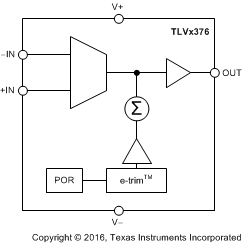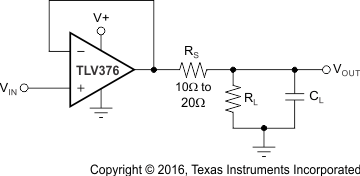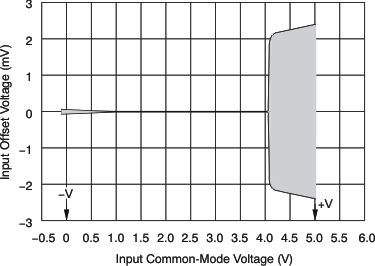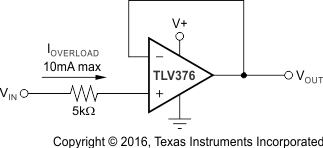SBOS755 October 2016 TLV2376 , TLV376 , TLV4376
PRODUCTION DATA.
- 1 Features
- 2 Applications
- 3 Description
- 4 Revision History
- 5 Pin Configuration and Functions
- 6 Specifications
- 7 Detailed Description
- 8 Application and Implementation
- 9 Power Supply Recommendations
- 10Layout
- 11Device and Documentation Support
- 12Mechanical, Packaging, and Orderable Information
Package Options
Mechanical Data (Package|Pins)
Thermal pad, mechanical data (Package|Pins)
Orderable Information
7 Detailed Description
7.1 Overview
The TLVx376 family belongs to a new generation of low-noise operational amplifiers with e-trim™, giving customers outstanding dc precision and ac performance. Low noise, rail-to-rail input and output, and low offset, drawing a low quiescent current, make these devices ideal for a variety of precision and portable applications. In addition, this family of devices have a wide supply range with excellent PSRR, making the TLVx376 a suitable option for applications that are battery-powered without regulation.
7.2 Functional Block Diagram

7.3 Feature Description
The TLVx376 family of precision amplifiers offers excellent dc performance as well as excellent ac performance. Operating from a single power supply, the TLVx376 is capable of driving large capacitive loads, has a wide input common-mode voltage range, and is well-suited to drive the inputs of successive-approximation register (SAR) analog-to-digital converters (ADCs) as well as 24-bit and higher resolution converters. All devices feature internal ESD protection. The TLVx376 family is offered in a variety of industry-standard packages for applications that require space savings.
7.3.1 Operating Voltage
The TLVx376 family of amplifiers operate over a power-supply range of 2.2 V to 5.5 V (±1.1 V to ±2.75 V). Many of the specifications apply from –40°C to +125°C. Parameters that can exhibit significant variance with regard to operating voltage or temperature are presented in the Typical Characteristics section.
7.3.2 Capacitive Load and Stability
The TLVx376 series of amplifiers can be used in applications where driving a capacitive load is required. As with all op amps, there can be specific instances where the TLVx376 can become unstable, leading to oscillation. The particular op amp circuit configuration, layout, gain, and output loading are some of the factors to consider when establishing whether an amplifier is stable in operation or not. An op amp in the unity-gain (+1 V/V) buffer configuration and driving a capacitive load exhibits a greater tendency to be unstable than an amplifier operated at a higher noise gain. The capacitive load, in conjunction with the op amp output resistance, creates a pole within the feedback loop that degrades the phase margin. The phase margin reduces when the capacitive loading increases.
7.3.3 Input Offset Voltage and Input Offset Voltage Drift
The TLVx376 family of operational amplifiers is manufactured using TI's e-trim™ technology. Each amplifier is trimmed in production, thereby minimizing errors associated with input offset voltage and input offset voltage drift. The e-trim™ technology is a TI proprietary method of trimming internal device parameters during either wafer probing or final testing.
The TLVx376 in a unity-gain configuration can directly drive up to 250 pF of pure capacitive load. Increasing the gain enhances the ability of the amplifier to drive greater capacitive loads; see Figure 16. In unity-gain configurations, capacitive load drive can be improved by inserting a small (10 Ω to 20 Ω) resistor, RS, in series with the output, as shown in Figure 22. This resistor significantly reduces ringing and maintains dc performance for purely capacitive loads. However, if there is a resistive load in parallel with the capacitive load, a voltage divider is created, introducing a gain error at the output and slightly reducing the output swing. The error introduced is proportional to the ratio RS / RL, and is generally negligible at low output current levels.
 Figure 22. Improving Capacitive Load Drive
Figure 22. Improving Capacitive Load Drive
7.3.4 Common-Mode Voltage Range
The input common-mode voltage range of the TLVx376 series extends 100 mV beyond the supply rails. The offset voltage of the amplifier is very low, from approximately (V–) to (V+) – 1 V, as shown in Figure 23. The offset voltage increases when common-mode voltage exceeds (V+) –1 V. Common-mode rejection is specified from (V–) to (V+) – 1.3 V.
 Figure 23. Offset and Common-Mode Voltage
Figure 23. Offset and Common-Mode Voltage
Parameters that can vary across the common-mode voltage range are listed in Table 1.
Table 1. Parameters With Variation Across the Common-Mode Voltage Range
| PARAMETER | (V–) - 0.1 V < VCM < (V+) – 1.3 V | (V+) – 1.3 V < VCM < (V+) + 0.1 V | UNIT | |
|---|---|---|---|---|
| TYP | TYP | |||
| OFFSET VOLTAGE | ||||
| VOS | Input offset voltage | 40 | 2500 | μV |
| dVOS/dT | Offset voltage vs temperature | 1 | 25 | μV/°C |
| OPEN LOOP GAIN | ||||
| AOL | Open-loop voltage gain | 126 | 96 | dB |
| INPUT VOLTAGE RANGE | ||||
| CMRR | Common-mode rejection ratio | 88 | 43 | dB |
| FREQUENCY RESPONSE | ||||
| GBW | Gain-bandwidth product | 5.5 | 5.5 | MHz |
| PM | Phase margin | 72 | 72 | Degrees |
| SR | Slew rate, G = 1 | 2 | 1.1 | V/μs |
| NOISE | ||||
| en | Input voltage noise density, f = 1 kHz |
8 | 135 | nV/√Hz |
| in | Input current noise, f = 1 kHz | 2 | 47 | fA/√Hz |
7.3.5 Input and ESD Protection
The TLVx376 family incorporates internal electrostatic discharge (ESD) protection circuits on all pins. In the case of input and output pins, this protection primarily consists of current-steering diodes connected between the input and power-supply pins. These ESD protection diodes also provide in-circuit, input overdrive protection, as long as the current is limited to 10 mA as stated in the Absolute Maximum Ratings table. Figure 24 shows how a series input resistor can be added to the driven input to limit the input current. The added resistor contributes thermal noise at the amplifier input. In noise-sensitive applications, the value of this resistor must be as low as possible.
 Figure 24. Input Current Protection
Figure 24. Input Current Protection
7.4 Device Functional Modes
The TLVx376 family has a single functional mode and is operational when the power-supply voltage is greater than 2.2 V (±1.1 V). The maximum power-supply voltage for the TLVx376 family is 5.5 V (±2.75 V).